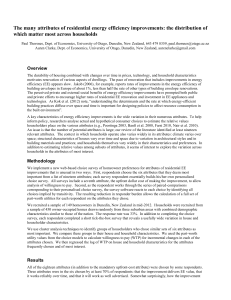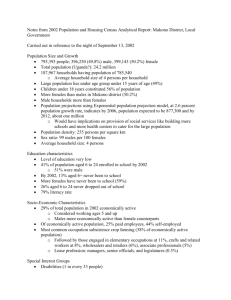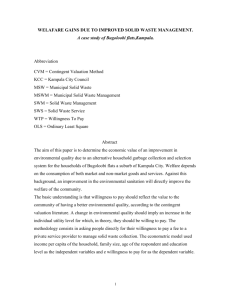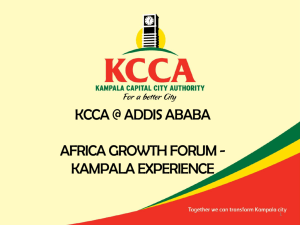Households' Willingness to Pay for Improved Municipal Solid Waste Management
advertisement
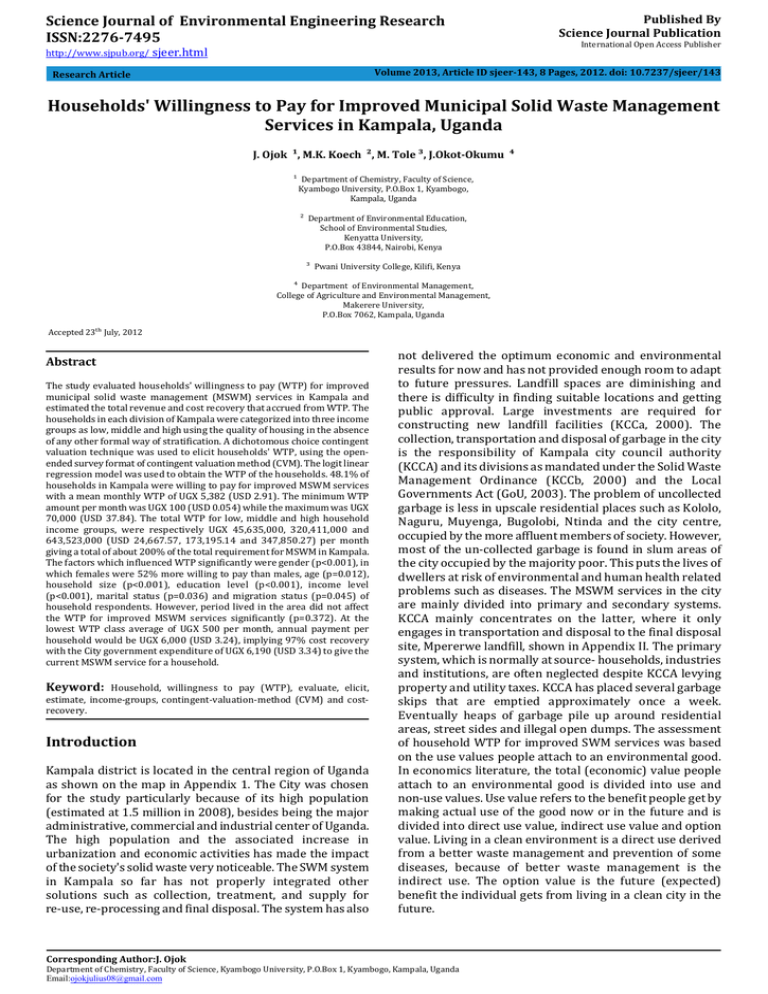
Science Journal of Environmental Engineering Research ISSN:2276-7495 http://www.sjpub.org/ sjeer.html Published By Science Journal Publication International Open Access Publisher Volume 2013, Article ID sjeer-143, 8 Pages, 2012. doi: 10.7237/sjeer/143 Research Article Households' Willingness to Pay for Improved Municipal Solid Waste Management Services in Kampala, Uganda J. Ojok ¹, M.K. Koech ², M. Tole ³, J.Okot­Okumu ⁴ ¹ Department of Chemistry, Faculty of Science, Kyambogo University, P.O.Box 1, Kyambogo, Kampala, Uganda ² Department of Environmental Education, School of Environmental Studies, Kenyatta University, P.O.Box 43844, Nairobi, Kenya ³ Pwani University College, Kilifi, Kenya ⁴ Department of Environmental Management, College of Agriculture and Environmental Management, Makerere University, P.O.Box 7062, Kampala, Uganda Accepted 23�� July, 2012 Abstract The study evaluated households' willingness to pay (WTP) for improved municipal solid waste management (MSWM) services in Kampala and estimated the total revenue and cost recovery that accrued from WTP. The households in each division of Kampala were categorized into three income groups as low, middle and high using the quality of housing in the absence of any other formal way of stratification. A dichotomous choice contingent valuation technique was used to elicit households' WTP, using the openended survey format of contingent valuation method (CVM). The logit linear regression model was used to obtain the WTP of the households. 48.1% of households in Kampala were willing to pay for improved MSWM services with a mean monthly WTP of UGX 5,382 (USD 2.91). The minimum WTP amount per month was UGX 100 (USD 0.054) while the maximum was UGX 70,000 (USD 37.84). The total WTP for low, middle and high household income groups, were respectively UGX 45,635,000, 320,411,000 and 643,523,000 (USD 24,667.57, 173,195.14 and 347,850.27) per month giving a total of about 200% of the total requirement for MSWM in Kampala. The factors which influenced WTP significantly were gender (p<0.001), in which females were 52% more willing to pay than males, age (p=0.012), household size (p<0.001), education level (p<0.001), income level (p<0.001), marital status (p=0.036) and migration status (p=0.045) of household respondents. However, period lived in the area did not affect the WTP for improved MSWM services significantly (p=0.372). At the lowest WTP class average of UGX 500 per month, annual payment per household would be UGX 6,000 (USD 3.24), implying 97% cost recovery with the City government expenditure of UGX 6,190 (USD 3.34) to give the current MSWM service for a household. Keyword: Household, willingness to pay (WTP), evaluate, elicit, estimate, income-groups, contingent-valuation-method (CVM) and costrecovery. Introduction Kampala district is located in the central region of Uganda as shown on the map in Appendix 1. The City was chosen for the study particularly because of its high population (estimated at 1.5 million in 2008), besides being the major administrative, commercial and industrial center of Uganda. The high population and the associated increase in urbanization and economic activities has made the impact of the society's solid waste very noticeable. The SWM system in Kampala so far has not properly integrated other solutions such as collection, treatment, and supply for re-use, re-processing and final disposal. The system has also not delivered the optimum economic and environmental results for now and has not provided enough room to adapt to future pressures. Landfill spaces are diminishing and there is difficulty in finding suitable locations and getting public approval. Large investments are required for constructing new landfill facilities (KCCa, 2000). The collection, transportation and disposal of garbage in the city is the responsibility of Kampala city council authority (KCCA) and its divisions as mandated under the Solid Waste Management Ordinance (KCCb, 2000) and the Local Governments Act (GoU, 2003). The problem of uncollected garbage is less in upscale residential places such as Kololo, Naguru, Muyenga, Bugolobi, Ntinda and the city centre, occupied by the more affluent members of society. However, most of the un-collected garbage is found in slum areas of the city occupied by the majority poor. This puts the lives of dwellers at risk of environmental and human health related problems such as diseases. The MSWM services in the city are mainly divided into primary and secondary systems. KCCA mainly concentrates on the latter, where it only engages in transportation and disposal to the final disposal site, Mpererwe landfill, shown in Appendix II. The primary system, which is normally at source- households, industries and institutions, are often neglected despite KCCA levying property and utility taxes. KCCA has placed several garbage skips that are emptied approximately once a week. Eventually heaps of garbage pile up around residential areas, street sides and illegal open dumps. The assessment of household WTP for improved SWM services was based on the use values people attach to an environmental good. In economics literature, the total (economic) value people attach to an environmental good is divided into use and non-use values. Use value refers to the benefit people get by making actual use of the good now or in the future and is divided into direct use value, indirect use value and option value. Living in a clean environment is a direct use derived from a better waste management and prevention of some diseases, because of better waste management is the indirect use. The option value is the future (expected) benefit the individual gets from living in a clean city in the future. Corresponding Author:J. Ojok Department of Chemistry, Faculty of Science, Kyambogo University, P.O.Box 1, Kyambogo, Kampala, Uganda Email:ojokjulius08@gmail.com Page 2 Science Journal of Environmental Engineering Research (ISSN:2276-7495) Materials and Methods Study areas The study concentrated on the five administrative divisions of the City, (Central, Kawempe, Makindye, Nakawa and Rubaga) shown in Appendix 1. WTP for improved SWM involves demand estimation, and its main determinant was expected to be income. In each division, the households were divided into three income groups of low, middle and high using the quality of housing in the absence of any other formal way of stratification. Data collection A systematic sampling technique was used for the next stage whereby every 3rd building in the selected parishes was sampled. A total of 4015 households were sampled from all the five divisions while considering the total projected population and housing in Kampala in 2008 as detailed in table 1 below. The Contingent Valuation Method (CVM), an environmental valuation technique, was used to estimate the value people attach to environmental amenity or services. Since there are no existing markets for environmental goods, people's valuation for these kinds of goods are derived from "hidden" or implicit markets by constructing artificial markets where people are asked to reveal their preferences. The open-ended format of CVM was used in this survey and involved asking the respondent what maximum price they were willing to pay for improved SWM services. This method had the advantage of avoiding starting point biases. But it was characterized by large numbers of non-responses and protest zeros due to the difficulty household respondents faced to pick a value out of the air without some form of assistance (Mitchell and Carson, 1988). Table 1: The total projected population and housing in Kampala in 2008, the required number of samples at 95% confidence level (CL) and number of samples obtained per division 2008 Population and Housing Projections Division Total Land Area (km²) Total Number of Required Number Parishes Samples of Parishes Sampled at 95% CL Number Sampled Central Kawempe Makindye Nakawa Rubaga Total 1508100 390009 163·0 99 54 1911 4015 Source: UBOS, 2007 (for population and housing, total land area and total number of parishes per division) Estimation of total WTP for the different household income groups Results WTP for improved MSWM services Based on the total projected population and housing in Kampala in 2008 in which there were 390,009 households and an average family size of 3.9 (UBOS, 2007), the WTP for improved MSWM services in Kampala was estimated. Households were asked whether they were willing to pay for improved MSWM services and the responses from 3969 households were recorded in table 2 below. Table 2: WTP for improved MSWM in Kampala Response Divisions (figures in % of total HHs) Makindye Central % of total Total HH HHs Response Rubaga Kawempe Nakawa Yes No Total How to Cite this Article: OJ. Ojok , M.K. Koech , M. Tole, J.Okot-Okumu “Households' Willingness to Pay for Improved Municipal Solid Waste Management Services in Kampala, Uganda”Science Journal of Environmental Engineering Research, Volume 2013, Article ID sjeer-143, 8 Pages, 2012. doi: 10.7237/sjeer/143 Science Journal of Environmental Engineering Research (ISSN:2276-7495) Likelihood estimates for the determinants of WTP (Logit model) Page 3 question was regressed against socioeconomic characteristics of the households and the results reported in table 3 below. To identify the factors influencing WTP for improved SWM by households, the household responses to the WTP Table 3: Determinants of WTP for improved SWM services (Logit model) Explanatory Variables Sex Age Education Occupation Migration Status Marital Status Period lived No. of people in HH Regression coefficient 0.73483 0.08905 -0.06301 0.02061 0.20016 -0.02072 -0.2721 0.72989 Stan. Error Coeff./S.E p-values 0.29684 0.04717 0.03225 0.01411 0.09707 0.06082 0.05329 0.28879 2.47551 1.88803 -1.95399 1.46064 2.0621 -0.34074 -5.10559 2.52738 0·000 0·012 0·000 0·000 0·045 0·036 0·372 0·000 Estimation of total WTP for the different household income groups willing to pay per month and the responses from 1369 households were summarized in table 4 below. Households who were willing to pay for improved MSWM services were further asked how much money they were Table 4: Estimated total WTP for the different household income groups Class bound ary 1 UGX Up to 1000 1001– 2000 2001– 4000 4001– 6000 6001– 10000 100020000 2000130000 3000140000 4000150000 5000170000 Class mark Sample distribution 2 UGX 3 No. 4 % Total HHs willing to pay 5 No. 500 478 34.9 65470 1500 351 25.6 48024 3000 73 5.3 9943 318 954000 5000 140 10.2 19135 230 1150000 12571 62855000 8000 155 11.3 21198 85 680000 16153 129224 000 15000 76 5.6 10505 84 1260000 1681 25215000 25000 38 2.8 5253 0 0 394 9850000 35000 37 2.7 5065 0 0 557 19495000 45000 17 1.3 2439 0 0 124 5580000 60000 4 0·3 563 0 0 0 0 WTP for different Income Groups Low Income 6 HHs 7 UGX 23078 46156 000 18513 12342 000 Middle Income 8 HHs 9 UGX 14011 7005500 30351 45526500 5220 45635 81062 000 Mean – – – – – 771 – Note that USD 1 = UGX 1852 at the time of data collection (2009). Total – 1336 100·0 187595 59215 From the class intervals for the WTP amounts, the class mark (mid-point of WTP amounts) was calculated and the 15660000 320411 000 3953 High Income 10 HHs Total WTP 11 UGX 12 UGX 32735 5303 2651500 000 72036 5331 7996500 000 13215 29829 4405 000 000 31670 95675 6334 000 000 39680 169584 4960 000 000 131100 157575 8740 000 000 121475 131325 4859 000 000 157780 177275 4508 000 000 104175 109755 2315 000 000 33780 33780 563 000 000 643523 1009569 47318 000 000 – 13600 5382 results presented in table 4 (col. 2). The total number of households willing to pay (col. 5) was obtained by taking How to Cite this Article: OJ. Ojok , M.K. Koech , M. Tole, J.Okot-Okumu “Households' Willingness to Pay for Improved Municipal Solid Waste Management Services in Kampala, Uganda”Science Journal of Environmental Engineering Research, Volume 2013, Article ID sjeer-143, 8 Pages, 2012. doi: 10.7237/sjeer/143 Page 4 Science Journal of Environmental Engineering Research (ISSN:2276-7495) the proportion of sample households falling in that boundary (col. 4) and multiplying by the total number of households willing to pay for improved SWM services (48.1% of the total projected households in Kampala in 2008 of 390,009). The number of households in each income group (cols.6, 8 and 10 for low, middle and high respectively) were obtained basing on total proportions (col.4), the stated amounts of WTP for each income group and the total households willing to pay in that class boundary (col. 5). To obtain the WTP for the different household income groups (cols. 7, 9 and 11 for low, middle and high income groups respectively), the number of households in each WTP class boundary of each income group (col. 6, 8, and 10) was multiplied by the corresponding class mark (col. 2). The total WTP (col. 12) was the summation of WTP of the different income groups (cols. 7, 9 and 11) in the different class boundaries (which is the same as multiplying col. 5 and the corresponding class mark in col. 2). Estimation of aggregate benefits of WTP in total revenue and cost recovery The aggregate benefits of WTP in total revenue at various prices that households in Kampala were willing to pay was calculated and presented in table 5 below. Table 5: Estimated aggregate benefits of WTP in total revenue Class boundary Class mark 1 (UGX) Up to 1000 1001 – 2000 2001 – 4000 4001 – 6000 6001 – 10000 10001 20000 20001 30000 30001 40000 40001 50000 2 (UGX) 50001 70000 Total Total No. of HHs Sample distribution willing to pay 3 4 5 (No.) (%) (No.) Total WTP Total HHs willing to pay at least that amount (Cumulative.) 6 (UGX) 7 (No.) 8 (%) 9 (No.) Total revenue 10 (UGX) 500 478 34.9 65470 32735000 1369 100 187595 93797500 1500 351 25.6 48024 72036000 891 65.1 122125 3000 73 5.3 9943 29829000 540 39.5 74101 5000 140 10.2 19135 95675000 467 34.2 64158 8000 155 11.3 21198 327 24 45023 15000 76 5.6 10505 172 12.7 23825 25000 38 2.8 5253 96 7.1 13320 35000 37 2.7 5065 58 4.3 8067 45000 17 1.3 2439 109755 000 21 1.6 3002 135090 000 60000 4 0·3 563 33780000 4 0·3 563 33780000 169584 000 157575 000 131325 000 177275 000 183187 500 222303 000 320790 000 360184 000 357375 000 333000 000 282345 000 1009569 000 Note that USD 1 = UGX 1852 at the time of data collection (2009). 1369 100·0 187595 To make the aggregation, the class mark was utilized to compute total WTP (col. 6) and subsequently, total revenue (col. 10). The demand curve for improved solid waste management was derived from the total HHs willing to pay at least a particular amount (figure 1). The total revenue (col. 10) from WTP a given amount (class mark) was obtained by multiplying the class mark by the corresponding total number of households willing to pay at least that amount (col. 9). The trend exhibited in table 4 (col. 10) is depicted on the graph in figure 2 where total revenue first increased as monthly payment increased and reached a maximum of UGX 360,184,000 when the monthly payment was UGX 8,000 per month. After that it decreased and reached a minimum of UGX 33,780,000 per month at the highest WTP of UGX 60,000 (class mark) due to a small number of households (only 563) willing to pay that amount. How to Cite this Article: OJ. Ojok , M.K. Koech , M. Tole, J.Okot-Okumu “Households' Willingness to Pay for Improved Municipal Solid Waste Management Services in Kampala, Uganda”Science Journal of Environmental Engineering Research, Volume 2013, Article ID sjeer-143, 8 Pages, 2012. doi: 10.7237/sjeer/143 Science Journal of Environmental Engineering Research (ISSN:2276-7495) Page 5 Figure 1: Estimated demand curve for improved MSWM services in Kampala Figure 2: Estimated total revenue from improved MSWM services in Kampala Discussion Table 1 revealed that 48.1% of households in Kampala were willing to pay for improved MSWM, the main reason being that MSWM was beneficial to all and therefore should be the responsibility of everybody, while those not willing to pay reasoned that MSWM was the sole responsibility of KCCA and therefore it (KCCA) ought to be responsible. However, WTP for MSWM services in Kampala, being a new practice, attracted a fairly low percentage of households compared to other cities where the practice has been going on. A similar study carried out in Addis Ababa using CVM for elicitation of WTP for improved SWM services revealed that 91% of households were willing to cooperate with government in financing SWM in order to improve their condition (Aklilu, 2002). The results revealed that sex of household respondent affected the WTP significantly (p<0.001) and further regression showed that female respondents were 52% more willing to pay for SWM than males. This was probably because traditionally it was the role of women to clean the house and dispose the waste and therefore they bore more responsibility towards SWM in a household. Age of the household respondents affected the How to Cite this Article: OJ. Ojok , M.K. Koech , M. Tole, J.Okot-Okumu “Households' Willingness to Pay for Improved Municipal Solid Waste Management Services in Kampala, Uganda”Science Journal of Environmental Engineering Research, Volume 2013, Article ID sjeer-143, 8 Pages, 2012. doi: 10.7237/sjeer/143 Page 6 WTP for improved MSWM services significantly (p = 0.012). The middle age group in the age range of 21 to 60 were found to be more willing to pay for improved MSWM than older ones (above 60) and younger ones (below 20). This was because old people (above 60) considered SWM as government's responsibility while young ones (below 20) just did not feel responsible for improved SWM and were therefore less willing to pay for it. The middle age generation, with big family responsibilities, better understood the implications of poor MSWM and were more familiar with cost sharing and were therefore more willing to pay for improved MSWM services. The education level of the household respondents significantly affected the WTP for improved MSWM services (p<0.001). The household respondents who had attained secondary, post-secondary and graduate level education were more willing to pay for improved SWM. This was because of the high level of understanding about the desirability of proper management of solid waste. The major occupation of household respondents, which entered the model as a proxy of income, affected the WTP significantly (p<0.001). The business/self employed respondents, public servants and community leaders, who were regarded as employed, were more willing to pay for improved SWM services than the unemployed. This finding confirmed the general agreement in environmental economics literature on the positive relationship between income and demand for improvement in environmental quality. Table 3 also revealed that migration status of the households affected the WTP for improved SWM services significantly (p = 0.045). Further regression revealed that migrants from urban areas were more willing to pay for improved SWM services than those from rural areas. This was due to the fact that people from urban settings are usually more responsible to keep the environment clean since they understand environmental problems better. Those in rural areas do not see waste disposal as a problem since there is plenty of land to get rid of the wastes. The marital status of household respondents affected the WTP for improved SWM services significantly (p = 0.036). This was due to the fact that married people were more responsible to keep the environment clean compared to single ones because married respondents had larger family size and hence faced higher risks of hygiene associated diseases than those not married. Period lived in the area did not affect the WTP for improved SWM services significantly (p = 0.372) probably because most respondents lived in a particular area only for short periods (less than 5 years) and those who lived longer (more than 5 years) were in the suburbs of the City and MSWM was not much of a problem to them. The household size significantly affected WTP for improved SWM services (p<0.001). This was due to the fact that the more number of people in the household, the more the waste generated, hence disposal becomes a problem. Households are thus more willing to pay in order to keep a clean environment. In another study carried out in two divisions in Kampala (Nakawa and Rubaga) to establish the determinants of WTP for SWM in Kampala city, the logistic regression estimates revealed that the age of the household head had a negative and significant effect on WTP for SWM (Niringiye, 2010). The results also showed that respondent's Science Journal of Environmental Engineering Research (ISSN:2276-7495) level of education, marital status, quantity of waste generated, household size and household expenditure did not significantly influence WTP for waste management. This was however, noted to be in contrast to earlier findings (Alta and Dehazo, 1996; World Bank, 1995). Another study of the economics of SWM in Uganda also confirmed that the amount to be paid for improved SWM services is influenced by household's income, age, education and gender of the household respondents (EDI, 2010). Table 4 revealed that the mean WTP for improved SWM services for Kampala was UGX 5,382, but varied with the household income groups as follows: UGX 771, 3,953 and 13,600 per month for low, medium and high respectively. The demand curve for improved solid waste management (figure 1) had a negative slope like most economic goods under normal conditions. This implied that increasing WTP had a disincentive effect on the demand for improved solid waste management, keeping all other factors constant. Table 5 revealed that the total WTP were UGX 45,635,000, 320,411,000 and 643,523,000 per month for low, middle and high household income groups respectively, with a grand total of UGX 1,009,569,000 per month (or UGX 12,114,828,000 per year) which the 48.1% of all households in Kampala who were willing to pay for improved MSWM services would pay if the suggested improved solid waste management was to be a reality. The estimated total revenue increased with the class mark up to a maximum and declined as the class mark increased to a minimum at the highest class mark as depicted in figure 2. In the value for money audit report on SWM in Kampala, carried out by the office of the auditor general of Uganda in March 2010, the amount of money spent on MSWM in Kampala in the financial year 2006/2007 was UGX 2,414,384,558 (OAG, 2010). These were operational costs only, involving garbage collection, transportation and disposal activities for a total collection coverage of 40% (OAG, 2010). This implied that for 100% coverage, the total expenditure for KCC would be UGX 6,035,961,395. The 48.1% of those willing to pay would therefore collect about 200% of the total requirement for MSWM in Kampala per year. From the audited expenditure for MSWM of Kampala for 2006/2007, the City government spent UGX 6,190 per year to give the current MSWM service for a household (OAG, 2010). At the lowest WTP class mark of UGX 500 per month, annual payment from a household would be UGX 6,000, which implies 97% cost recovery. But, this is only if KCCA charges the lowest WTP amount to all households willing to pay for improved MSWM services. And if the different income group areas were to be charged their mean willingness to pay, then the amount collected from a household in low, middle and high income areas with respective mean values of UGX 771, 3,953 and 13,600 per month would respectively be UGX 9,252, 47,436 and 163,200. This suggests that there is a very wide room for cost recovery by improving the existing service although the values given by households in the survey was not for the existing service but for the hypothetical improvement. A similar study in Addis Ababa revealed that 91% of households were willing to cooperate with government in financing SWM and the mean monthly WTP was Ethiopian Birr 7.07 per month per household, but for the various How to Cite this Article: OJ. Ojok , M.K. Koech , M. Tole, J.Okot-Okumu “Households' Willingness to Pay for Improved Municipal Solid Waste Management Services in Kampala, Uganda”Science Journal of Environmental Engineering Research, Volume 2013, Article ID sjeer-143, 8 Pages, 2012. doi: 10.7237/sjeer/143 Science Journal of Environmental Engineering Research (ISSN:2276-7495) income areas, the mean WTP were Ethiopian Birr 2.96, 7.76 and 13.07 per month for low, medium and high income areas respectively (Aklilu, 2002). A Tobit model regression revealed that income, time spent in the area, quantity of waste generated, education, house ownership, number of children and age of respondent were significant variables in explaining maximum WTP. This study revealed 83.2% cost recovery, suggesting a very wide room for cost recovery by improving the existing SWM services in Addis Ababa (Aklilu, 2002). Conclusions Households in Kampala are willing to pay for improved MSWM services (48.1%) ranging from UGX 100 to 70,000 (USD 0.054 to 37.8) per month. Improving MSWM service from its very low current level would not be more costly to KCCA than the current service since households in Kampala are willing to pay for the service. There is a possibility of cross subsidy in case some households are unable or unwilling to pay since the higher class marks are giving higher WTP amounts. There is also a very wide room for cost recovery by improving the existing service. Page 7 http:www.efdinitiative.org/research/projects/projectrepository/the economics-of-solid-waste-management, accessed, 21-09-2010. 4. GoU (Government of Uganda), 2003. Local Government Act 2003. Kampala, Uganda. 5. KCCa (Kampala City Council), 2000. Waste Collection in Kampala City, Jan-June, 2000. Kampala, Uganda. 6. KCCb (Kampala City Council), 2000. Solid Waste Ordinance. Kampala, Uganda 7. Mitchell, R.C. and Carson, R. T., 1989. Using surveys to value Public Goods: The Contingent Valuation Method. Washington, DC: Resource for the Future. 8. Niringiye, A. and Omortor, D.G., 2010. Determinants of Willingness to Pay for Solid Waste Management in Kampala City 9. OAG (Office of the Auditor General of Uganda), March 2010. Value for Money Audit Report on Solid Waste Management in Kampala. Kampala. 10. UBOS (Uganda Bureau of Statistics), 2007. Projection Population Report, 2003 - 2017. Kampala. 11. World Bank, 1995. Towards Sustainable Management of Water Resources. World Bank Publications, Washington, ISBN: 13: 9780821334133. References 1. Aklilu, A., 2002. Household's Willingness to Pay for Improved Solid Waste Management: The Case of Addis Ababa. 2. Alta, A.A. and Deshaz, O.J., 1996. Households demand for improved solid waste management, a case study of Gujarwala Pakistan. Word Dev., 24(5): 857-868. 3. EDI (Environment for Development Initiative), 2010. The Economics of Solid Waste Management: The Case of Kampala, Uganda (PhD Thesis). Available at: Appendix I Map of Africa showing location of Uganda and Kampala district administrative divisions (Source: UBOS, 2007) How to Cite this Article: OJ. Ojok , M.K. Koech , M. Tole, J.Okot-Okumu “Households' Willingness to Pay for Improved Municipal Solid Waste Management Services in Kampala, Uganda”Science Journal of Environmental Engineering Research, Volume 2013, Article ID sjeer-143, 8 Pages, 2012. doi: 10.7237/sjeer/143 Page 8 Science Journal of Environmental Engineering Research (ISSN:2276-7495) Appendix II Map of Kampala and part of Wakiso Districts showing the location of Mpererwe Landfill How to Cite this Article: OJ. Ojok , M.K. Koech , M. Tole, J.Okot-Okumu “Households' Willingness to Pay for Improved Municipal Solid Waste Management Services in Kampala, Uganda”Science Journal of Environmental Engineering Research, Volume 2013, Article ID sjeer-143, 8 Pages, 2012. doi: 10.7237/sjeer/143
